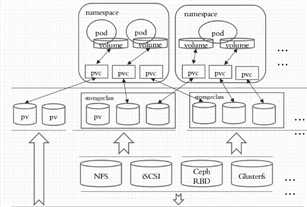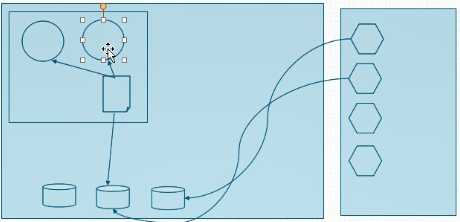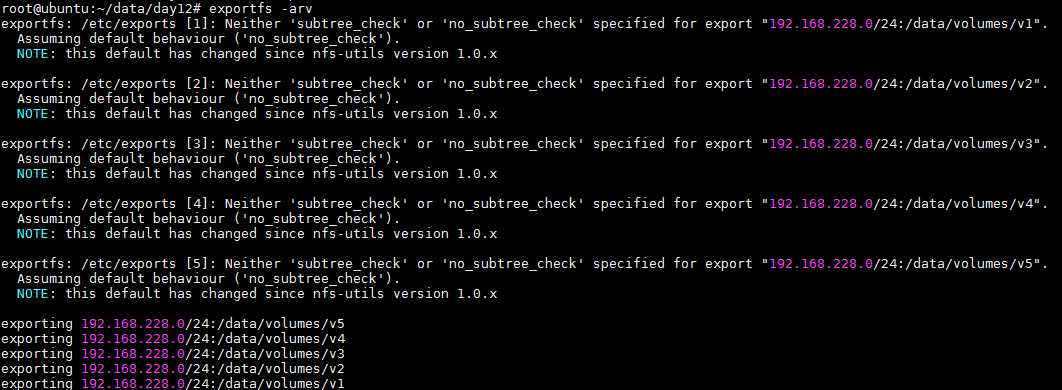标签:required 为我 this use select attribute 等于 共享 ntp
1、概述,我们可以这样来组织我们的存储,在pod中我们只需要定义一个存储卷并且定义的时候我只需要说明我需要多大的存储卷就行了,这个存储卷叫pvc类型的存储卷,而pvc类型的存储卷必须与当前名称空间中的pvc建立直接绑定关系,而pvc必须与pv建立绑定关系,而pv应该是真正某个存储设备上的存储空间,所以pv和pvc是k8s系统之上的抽象的但也算是标准的资源,pvc是一种资源,pv也是一种资源,他的创建方式和我们此前创建其它资源方式是一样的,但是用户需要怎么做呢?存储工程师把每个存储空间先划割好,k8s管理员需要把每一个存储空间映射到系统上做成pv,用户就自己定义pod,在pod中定义使用pvc就可以了,但是pvc也需要创建,也需要我们k8s工程师把pvc也做好,但是pv和pvc之间,在pvc不被调用时是空载没有用的,当有pod调用pvc的时候他需要与某个pv绑定起来,相当于这个pvc上的数据是放在哪个pv上的,pvc要绑定哪个pv取决于pod创建者用户在创建中定义我要请求使用多大的存储空间。比如我要使用一个5G的,于是在当前系统上我们要找一个pvc与容纳5G的pv建立绑定关系,2G的就不符合条件。并且我们还可以指明说我创建使用这个pv必须只能有一个人挂载和读写使用。


KIND: Pod VERSION: v1 RESOURCE: persistentVolumeClaim <Object> DESCRIPTION: PersistentVolumeClaimVolumeSource represents a reference to a PersistentVolumeClaim in the same namespace. More info: https://kubernetes.io/docs/concepts/storage/persistent-volumes#persistentvolumeclaims PersistentVolumeClaimVolumeSource references the user‘s PVC in the same namespace. This volume finds the bound PV and mounts that volume for the pod. A PersistentVolumeClaimVolumeSource is, essentially, a wrapper around another type of volume that is owned by someone else (the system). FIELDS: claimName <string> -required- #需要使用的pvc名称 ClaimName is the name of a PersistentVolumeClaim in the same namespace as the pod using this volume. More info: https://kubernetes.io/docs/concepts/storage/persistent-volumes#persistentvolumeclaims readOnly <boolean> #当前名称空间中已经有一个用户做好pvc了 Will force the ReadOnly setting in VolumeMounts. Default false.

KIND: PersistentVolumeClaim VERSION: v1 RESOURCE: spec <Object> DESCRIPTION: Spec defines the desired characteristics of a volume requested by a pod author. More info: https://kubernetes.io/docs/concepts/storage/persistent-volumes#persistentvolumeclaims PersistentVolumeClaimSpec describes the common attributes of storage devices and allows a Source for provider-specific attributes FIELDS: accessModes <[]string> #访问模型, AccessModes contains the desired access modes the volume should have. More info: https://kubernetes.io/docs/concepts/storage/persistent-volumes#access-modes-1 resources <Object> #资源限制,至少多少,如果设置为10G的那么至少需要10G的pv Resources represents the minimum resources the volume should have. More info: https://kubernetes.io/docs/concepts/storage/persistent-volumes#resources selector <Object> #标签选择器,表示可以必须选择哪个pv建立关联关系,不加标签就在所有里面找最佳匹配 A label query over volumes to consider for binding. storageClassName <string> #存储类名称 Name of the StorageClass required by the claim. More info: https://kubernetes.io/docs/concepts/storage/persistent-volumes#class-1 volumeMode <string> #后端存储卷模式 volumeMode defines what type of volume is required by the claim. Value of Filesystem is implied when not included in claim spec. This is an alpha feature and may change in the future. volumeName <string> #卷名称,后端pv的名称,精确选择时候匹配 VolumeName is the binding reference to the PersistentVolume backing this claim.
创建完pvc后就会找系统上合适的pv绑定,如果有就绑定,如果没有就pvc pending(挂起),表示没有合适的pv被这个pvc所claim,pvc此时被阻塞,直到有合适的pv被此pvc所调用为止。
首先我们系统上应该是要有存储设备,存储管理员在上面划割好了很多很多可被独立使用的存储空间,然后我们的集群管理工程师把这每一个空间都引入到集群中把它定义成pv,因为我们集群管理员或存储工程师才更了解这些存储设备的参数,他们必须要了解存储设备怎么被创建,并且知道这些参数怎么被调用,随后我们的k8s使用者创建pod时要先创建一个pvc,意思是说我们要在当前的k8s集群中找一个符合我们条件的存储空间来用,于是就定义pvc的使用标准,而后我们系统就在里面找哪个最合适,然后申请。pv和pvc是一一对应关系,也就是说如果某个pv被某个pvc占用了意味着他就不能再被其它pvc所占用了,如果pvc被占用了会显示这个状态叫binding,意思说被绑定在使用了,就不可能再被其它pv所占用了,但是一个pvc创建以后这个pvc就相当于是一个存储卷了,这个存储卷可以被多个pod所访问,假如多个pod挂载同一个存储卷就叫多路访问,因此我们创建pvc时最好确保下面有pv存在,如果不存在那么就绑定不了。

NFS server上创建多个挂载目录,并共享
mkdir -p /data/volumes/v{1..5} && ls /data/volumes/
创建 nfs 挂载目录
vi /etc/exports
编辑内容如下
/data/volumes/v1 192.168.228.0/24(rw,no_root_squash) /data/volumes/v2 192.168.228.0/24(rw,no_root_squash) /data/volumes/v3 192.168.228.0/24(rw,no_root_squash) /data/volumes/v4 192.168.228.0/24(rw,no_root_squash) /data/volumes/v5 192.168.228.0/24(rw,no_root_squash)
重新加载 nfs 挂载配置
exportfs -arv

查看 nfs 挂载的目录
showmount -e


apiVersion: v1 kind: PersistentVolume metadata: name: pv001 labels: name: pv001 spec: nfs: path: /data/volumes/v1 server: 192.168.228.138 accessModes: ["ReadWriteMany","ReadWriteOnce"] #多路读写,多路只读和单路读写 capacity: storage: 2Gi --- apiVersion: v1 kind: PersistentVolume metadata: name: pv002 labels: name: pv002 spec: nfs: path: /data/volumes/v2 server: 192.168.228.138 accessModes: ["ReadWriteOnce"] #多路读写,多路只读和单路读写 capacity: storage: 5Gi --- apiVersion: v1 kind: PersistentVolume metadata: name: pv003 labels: name: pv003 spec: nfs: path: /data/volumes/v3 server: 192.168.228.138 accessModes: ["ReadWriteMany","ReadWriteOnce"] #多路读写,多路只读和单路读写 capacity: storage: 20Gi --- apiVersion: v1 kind: PersistentVolume metadata: name: pv004 labels: name: pv004 spec: nfs: path: /data/volumes/v4 server: 192.168.228.138 accessModes: ["ReadWriteMany","ReadWriteOnce"] #多路读写,多路只读和单路读写 capacity: storage: 10Gi --- apiVersion: v1 kind: PersistentVolume metadata: name: pv005 labels: name: pv005 spec: nfs: path: /data/volumes/v5 server: 192.168.228.138 accessModes: ["ReadWriteMany","ReadWriteOnce"] #多路读写,多路只读和单路读写 capacity: storage: 10Gi ---
创建 pv

处于绑定状态下的pv无法直接被删除,如果需要删除被绑定的pv,需要先删除申请绑定的PVC
RECLAIM POLICY 回收策略是指,如果某个pvc绑定这个pv,在里面存数据了,但是后面这个pvc又释放了,我把pvc删了这个绑定就不存在了,一旦绑定不存在时里面存在数据的pv怎么办呢? Retain表示保留着,recover表示回收,表示把里面数据全删了,把pv置于空闲状态让其它pvc绑。还有一种叫delete,用完直接删除。一般来讲我们默认使用Retain。
定义pvc

VERSION: v1 RESOURCE: spec <Object> DESCRIPTION: Spec defines the desired characteristics of a volume requested by a pod author. More info: https://kubernetes.io/docs/concepts/storage/persistent-volumes#persistentvolumeclaims PersistentVolumeClaimSpec describes the common attributes of storage devices and allows a Source for provider-specific attributes FIELDS: accessModes <[]string> #他要求的访问模式一定是现存的某个pv的子集 AccessModes contains the desired access modes the volume should have. More info: https://kubernetes.io/docs/concepts/storage/persistent-volumes#access-modes-1 resources <map> #资源要求,一旦给了以后pv一定要大于等于这个值才能被使用 Resources represents the minimum resources the volume should have. More info: https://kubernetes.io/docs/concepts/storage/persistent-volumes#resources selector <Object> A label query over volumes to consider for binding. storageClassName <string> Name of the StorageClass required by the claim. More info: https://kubernetes.io/docs/concepts/storage/persistent-volumes#class-1 volumeMode <string> volumeMode defines what type of volume is required by the claim. Value of Filesystem is implied when not included in claim spec. This is an alpha feature and may change in the future. volumeName <string> VolumeName is the binding reference to the PersistentVolume backing this claim.

apiVersion: v1 kind: PersistentVolumeClaim metadata: name: mypvc namespace: default spec: accessModes: ["ReadWriteMany"] resources: requests: storage: 1Gi --- apiVersion: v1 kind: Pod metadata: name: pod-vol-pvc namespace: default spec: containers: - name: myapp image: ikubernetes/myapp:v1 volumeMounts: - name: html mountPath: /usr/share/nginx/html/ volumes: - name: html persistentVolumeClaim: #使用pvc claimName: mypvc #pvc名字
创建pvc 并声明 pod 使用

访问pod

kubernetes pv pvc configmap secret 使用
标签:required 为我 this use select attribute 等于 共享 ntp
原文地址:https://www.cnblogs.com/crazymagic/p/11333400.html